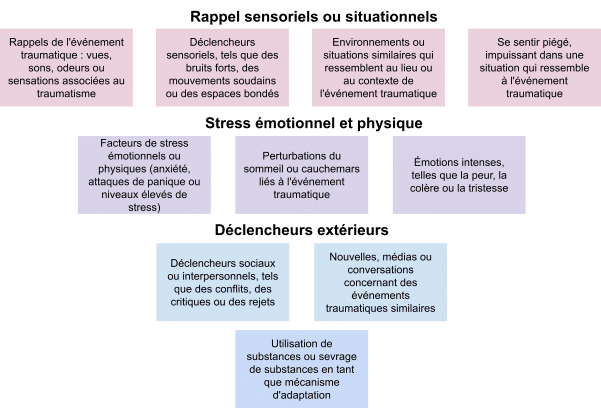Imagine someone who, after experiencing a traumatic event, finds themselves constantly on the alert, scanning their surroundings for invisible threats. They may find it difficult to concentrate on a simple conversation, or overreact to a sudden noise. For this person, the slightest situation can seem potentially dangerous, even if there’s nothing to indicate a real threat. This state of extreme alertness is known as hypervigilance, a phenomenon often linked to post-traumatic stress disorder (PTSD) and anxiety disorders. But beyond its psychological aspect, hypervigilance also affects crucial cognitive mechanisms: attention. This article explores how hypervigilance and its effects on attention can impact daily life, and why this knowledge is essential for massage practitioners, who play an important role in relaxation and stress management.
| Contents: What is hypervigilance? Attention: a key factor in hypervigilance Hypervigilance triggers The impact of hypervigilance on well-being The importance of attention management in massage Conclusion |
What is hypervigilance?
Hypervigilance is a form of anxiety in which a person becomes excessively aware of their environment, constantly looking for signs of danger. This defense mechanism can be activated in response to traumatic events, such as abuse, accidents or wartime situations, often observed in PTSD. This response can lead a person to perceive a threat even in non-threatening situations, resulting in prolonged activation of the sympathetic nervous system.
In individuals suffering from PTSD, hypervigilance manifests itself as nervous system overactivity. The body is constantly on the alert, ready to respond to any perceived danger, resulting in a series of physiological reactions: accelerated heart rate, excessive sweating, and heightened reactivity to stimuli. This stress response may also be accompanied by emotional symptoms such as anxiety, flashbacks, nightmares and angry outbursts. Behaviorally, hypervigilance can result in social avoidance, heightened aggression or flight behaviour.
Attention: a key factor in hypervigilance
To understand hypervigilance, it’s essential to look at the role of attention. Attention is the ability to direct cognitive resources towards specific information, selecting what is relevant to a given task. This mental function enables the individual to concentrate, analyze and act in a focused way in an environment often cluttered with distractions.
There are several types of attention, each with a specific role:
- Selective attention: This is the ability to concentrate on a particular stimulus while ignoring others. In a noisy environment, for example, selective attention enables a person to concentrate on a particular conversation without being disturbed by other sounds.
- Divided attention: This type of attention is required when we need to manage several tasks simultaneously. Driving while talking to a passenger is one example. This ability to divide attention is crucial in many everyday situations.
- Sustained attention or vigilance: Vigilance is the attitude of maintaining attention over a long period, often in situations where we need to remain alert without interruption. This may involve monotonous tasks, such as monitoring an environment for an extended period, or being alert to subtle changes in our surroundings, as when driving at night.
In hypervigilance, these different types of attention are often amplified or unbalanced. The traumatized person may have hyper-selective attention, constantly scanning for potential threats, while having difficulty concentrating on everyday tasks or interactions.
Hypervigilance triggers
Triggers can be highly varied and specific to each individual. They may include:

Managing these triggers requires an integrated approach, combining therapeutic strategies such as cognitive-behavioral therapy (CBT) with coping mechanisms such as breathing and mindfulness techniques.
The impact of hypervigilance on well-being
Hypervigilance can generate a constant state of mental and physical fatigue, as it places excessive demands on cognitive resources. Always being on the alert can disrupt sleep, provoke symptoms of chronic fatigue and impair interpersonal relationships. Furthermore, constant anxiety can lead to a deterioration in concentration, affecting work and social activities. These symptoms can become a real daily burden.
The importance of attention management in massage
For a massage therapist, understanding how attention works and how it is affected by hypervigilance enables relaxation techniques to be better adapted. For example, a person in a state of hypervigilance will find it difficult to relax immediately, as their attention is constantly mobilized by the search for danger. Massage can therefore help the person to redirect his or her attention by creating a calm, secure environment, allowing the mind to focus on pleasant, soothing sensations.
Conclusion
Hypervigilance is a natural defense mechanism in the face of danger, but when it becomes chronic, it can adversely affect quality of life and mental health. In post-traumatic stress disorder (PTSD), this phenomenon is particularly marked, profoundly affecting social relationships, work and even physical well-being. By understanding the different types of attention – selective, divided, sustained – and the effects of hypervigilance on these mechanisms, massage practitioners can better respond to their clients’ needs. Appropriate treatment, combined with stress management strategies, can help individuals reduce the symptoms of hypervigilance and return to a balanced life. By offering sessions that promote relaxation and attention management, they can help restore psychological balance, improve well-being and provide valuable support to those suffering from stress and anxiety-related disorders.
To remember:
- Hypervigilance is a constant state of alert linked to post-traumatic stress, where the individual perceives threats even in the absence of real danger.
- Attention plays a crucial role in hypervigilance, modifying the ability to focus, filter distractions and maintain prolonged vigilance.
- Triggers for hypervigilance vary, including sensory reminders, trauma-like situations, and emotional or social factors.
- Impact on well-being: Hypervigilance can cause mental fatigue, disrupt sleep and affect social relationships, necessitating stress management strategies.
Sources :
- American Psychiatric Association (2022). Diagnostic and Statistical Manual of Mental Disorders: DSM-5-TR.
- Hypervigilance and PTSD – PTSD UK (2023). https://www.ptsduk.org/hypervigilance-and-ptsd/
- Kimble, M., Boxwala, M., Bean, W., Maletsky, K., Halper, J., Spollen, K., & Fleming, K. (2014). The impact of hypervigilance: evidence for a forward feedback loop. Journal of anxiety disorders, 28(2), 241-245. https://doi.org/10.1016/j.janxdis.2013.12.006
- MSc, O. G. (2023). What is hypervigilance? a core symptom of PTSD. Simply Psychology. https://www.simplypsychology.org/hypervigilance.html
- Posner, M. I., & Petersen, S. E. (1990). The attention system of the human brain. Annual Review of Neuroscience, 13(1), 25-42. https://doi.org/10.1146/annurev.ne.13.030190.000325

